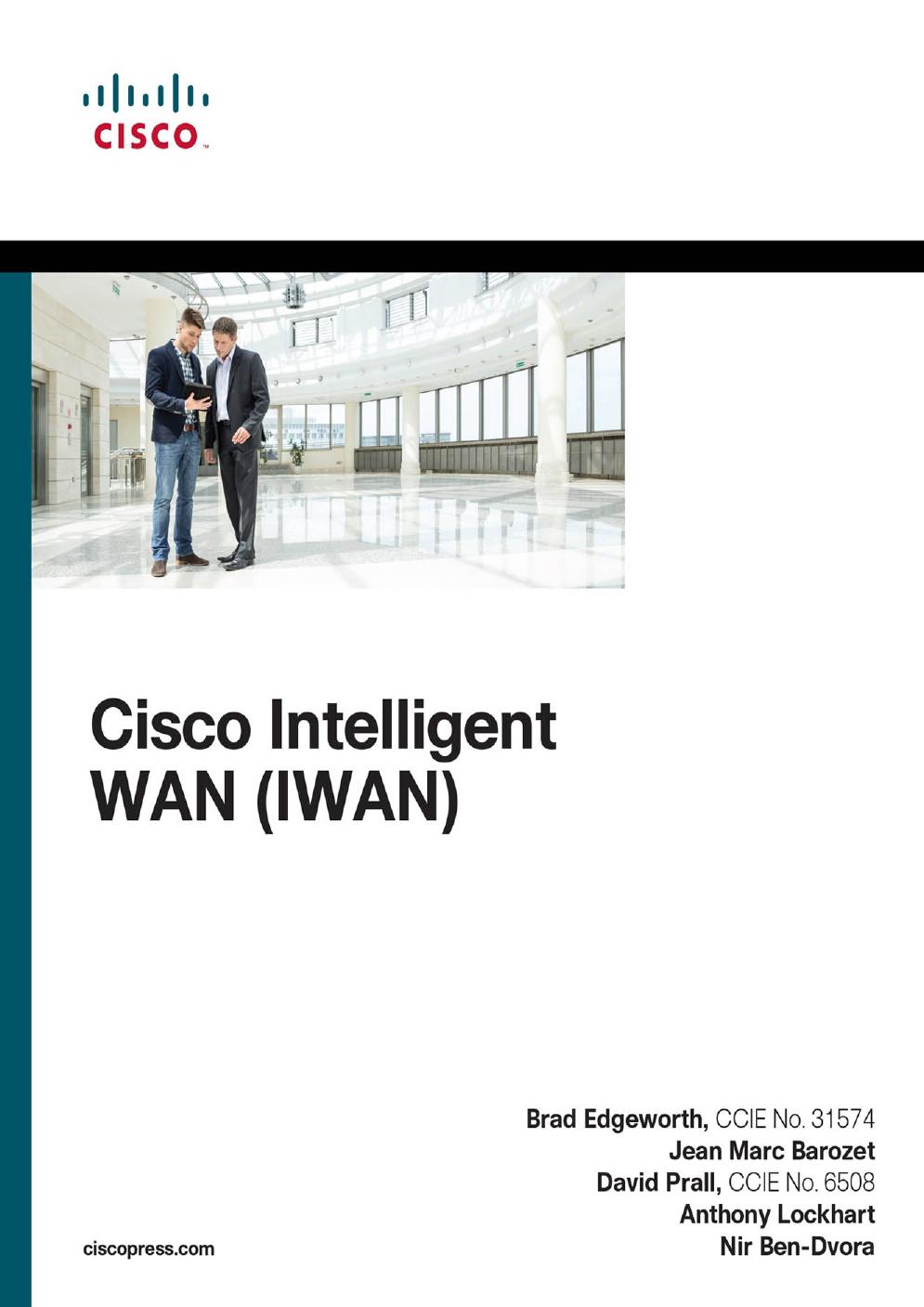Cisco Intelligent WAN IWAN 1st Edition by Brad Edgeworth, David Prall, Jean Marc Barozet, Anthony Lockhart, Nir Ben Dvora ISBN 0134423739 9780134423739
$70.00 Original price was: $70.00.$35.00Current price is: $35.00.
Instant download Cisco Press Cisco Intelligent WAN 1587144638 after payment
Cisco Intelligent WAN IWAN 1st Edition by Brad Edgeworth, David Prall, Jean Marc Barozet, Anthony Lockhart, Nir Ben Dvora – Ebook PDF Instant Download/Delivery: 0134423739, 9780134423739
Full dowload Cisco Intelligent WAN IWAN 1st Edition after payment

Product details:
ISBN 10: 0134423739
ISBN 13: 9780134423739
Author: Brad Edgeworth, David Prall, Jean Marc Barozet, Anthony Lockhart, Nir Ben Dvora
The complete guide to Cisco® IWAN: features, benefits, planning, and deployment Using Cisco Intelligent WAN (IWAN), businesses can deliver an uncompromised experience, security, and reliability to branch offices over any connection. Cisco IWAN simplifies WAN design, improves network responsiveness, and accelerates deployment of new services. Now, there’s an authoritative single-source guide to Cisco IWAN: all you need to understand it, design it, and deploy it for maximum value. In Cisco Intelligent WAN (IWAN), leading Cisco experts cover all key IWAN technologies and components, addressing issues ranging from visibility and provisioning to troubleshooting and optimization. They offer extensive practical guidance on migrating to IWAN from your existing WAN infrastructure. This guide will be indispensable for all experienced network professionals who support WANs, are deploying Cisco IWAN solutions, or use related technologies such as DMVPN or PfR. Deploy Hybrid WAN connectivity to increase WAN capacity and improve application performance Overlay DMVPN on WAN transport to simplify operations, gain transport independence, and improve VPN scalability Secure DMVPN tunnels and IWAN routers Use Application Recognition to support QoS, Performance Routing (PfR), and application visibility Improve application delivery and WAN efficiency via PfR Monitor hub, transit, and branch sites, traffic classes, and channels Add application-level visibility and per-application monitoring to IWAN routers Overcome latency and bandwidth inefficiencies that limit application performance Use Cisco WAAS to customize each location’s optimizations, application accelerations, and virtualization Smoothly integrate Cisco WAAS into branch office network infrastructure Ensure appropriate WAN application responsiveness and experience Improve SaaS application performance with Direct Internet Access (DIA) Perform pre-migration tasks, and prepare your current WAN for IWAN Migrate current point-to-point and multipoint technologies to IWAN
Cisco Intelligent WAN IWAN 1st Table of contents:
Part I: Introduction to IWAN
Chapter 1. Evolution of the WAN
WAN Connectivity
Leased Circuits
Internet
Multiprotocol Label Switching VPNs (MPLS VPNs)
Increasing Demands on Enterprise WANs
Server Virtualization and Consolidation
Cloud-Based Services
Collaboration Services
Bring Your Own Device (BYOD)
Guest Internet Access
Quality of Service for the WAN
Branch Internet Connectivity and Security
Centralized Internet Access
Distributed Internet Access
Cisco Intelligent WAN
Transport Independence
Intelligent Path Control
Application Optimization
Secure Connectivity
Software-Defined Networking (SDN) and Software-Defined WAN (SD-WAN)
Summary
Part II: Transport Independent Design
Chapter 2. Transport Independence
WAN Transport Technologies
Dial-Up
Leased Circuits
Virtual Circuits
Peer-to-Peer Networks
Broadband Networks
Cellular Wireless Networks
Virtual Private Networks (VPNs)
Multiprotocol Label Switching (MPLS) VPNs
Link Oversubscription on Multipoint Topologies
Dynamic Multipoint VPN (DMVPN)
Benefits of Transport Independence
Managing Bandwidth Cost
Leveraging the Internet
Intelligent WAN Transport Models
Summary
Chapter 3. Dynamic Multipoint VPN
Generic Routing Encapsulation (GRE) Tunnels
GRE Tunnel Configuration
GRE Example Configuration
Next Hop Resolution Protocol (NHRP)
Dynamic Multipoint VPN (DMVPN)
Phase 1: Spoke-to-Hub
Phase 2: Spoke-to-Spoke
Phase 3: Hierarchical Tree Spoke-to-Spoke
DMVPN Configuration
DMVPN Hub Configuration
DMVPN Spoke Configuration for DMVPN Phase 1 (Point-to-Point)
Viewing DMVPN Tunnel Status
Viewing the NHRP Cache
DMVPN Configuration for Phase 3 DMVPN (Multipoint)
Spoke-to-Spoke Communication
Forming Spoke-to-Spoke Tunnels
NHRP Route Table Manipulation
NHRP Route Table Manipulation with Summarization
Problems with Overlay Networks
Recursive Routing Problems
Outbound Interface Selection
Front-Door Virtual Route Forwarding (FVRF)
IP NHRP Authentication
Unique IP NHRP Registration
DMVPN Failure Detection and High Availability
NHRP Redundancy
NHRP Traffic Statistics
DMVPN Tunnel Health Monitoring
DMVPN Dual-Hub and Dual-Cloud Designs
IWAN DMVPN Sample Configurations
Sample IWAN DMVPN Transport Models
Backup Connectivity via Cellular Modem
Enhanced Object Tracking (EOT)
Embedded Event Manager
IWAN DMVPN Guidelines
Troubleshooting Tips
Summary
Further Reading
Chapter 4. Intelligent WAN (IWAN) Routing
Routing Protocol Overview
Topology
WAN Routing Principles
Multihomed Branch Routing
Route Summarization
Traffic Engineering for DMVPN and PfR
EIGRP for IWAN
Base Configuration
Verification of EIGRP Neighbor Adjacencies
EIGRP Stub Sites on Spokes
EIGRP Summarization
EIGRP Traffic Steering
Complete EIGRP Configuration
Advanced EIGRP Site Selection
Border Gateway Protocol (BGP)
BGP Routing Logic
Base Configuration
BGP Neighbor Sessions
Default Route Advertisement into BGP
Routes Learned via DMVPN Tunnel Are Always Preferred
Branch Router Configuration
Changing BGP Administrative Distance
Route Advertisement on DMVPN Hub Routers
Traffic Steering
Complete BGP Configuration
Advanced BGP Site Selection
FVRF Transport Routing
Multicast Routing
Multicast Distribution Trees
Rendezvous Points
Protocol Independent Multicast (PIM)
Source Specific Multicast (SSM)
Multicast Routing Table
IWAN Multicast Configuration
Hub-to-Spoke Multicast Stream
Spoke-to-Spoke Multicast Traffic
Summary
Further Reading
Chapter 5. Securing DMVPN Tunnels and Routers
Elements of Secure Transport
IPsec Fundamentals
Security Protocols
Key Management
Security Associations
ESP Modes
IPsec Tunnel Protection
Pre-shared Key Authentication
Verification of Encryption on IPsec Tunnels
Private Key Infrastructure (PKI)
IKEv2 Protection
Basic IOS CA Management
Securing Routers That Connect to the Internet
Access Control Lists (ACLs)
Zone-Based Firewalls (ZBFWs)
Control Plane Policing (CoPP)
IOS Embedded Packet Capture (EPC)
IOS XE Embedded Packet Capture
Analyzing and Creating the CoPP Policy
Device Hardening
Summary
Further Reading
Part III: Intelligent Path Control
Chapter 6. Application Recognition
What Is Application Recognition?
What Are the Benefits of Application Recognition?
NBAR2 Application Recognition
NBAR2 Application ID, Attributes, and Extracted Fields
NBAR2 Application ID
NBAR2 Application Attributes
NBAR2 Layer 7 Extracted Fields
NBAR2 Operation and Functions
Phases of Application Recognition
NBAR2 Engine and Best-Practice Configuration
Custom Applications and Attributes
Auto-learn Traffic Analysis Engine
Traffic Auto-customization
Manual Application Customization
Manual Application Attributes Customization
NBAR2 State with Regard to Device High Availability
Encrypted Traffic
NBAR2 Interoperability with Other Services
NBAR2 Protocol Discovery
Enabling NBAR2 Protocol Discovery
Displaying NBAR2 Protocol Discovery Statistics
Clearing NBAR2 Protocol Discovery Statistics
NBAR2 Visibility Dashboard
NBAR2 Protocol Packs
Release and Download of NBAR2 Protocol Packs
NBAR2 Protocol Pack License
Application Customization
NBAR2 Protocol Pack Types
NBAR2 Protocol Pack States
Identifying the NBAR2 Software Version
Verifying the Active NBAR2 Protocol Pack
Loading an NBAR2 Protocol Pack
NBAR2 Taxonomy File
Protocol Pack Auto Update
Validation and Troubleshooting


